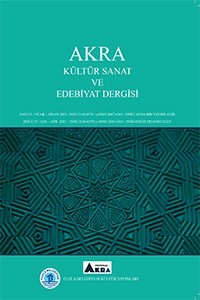Okuma güçlüğü olan bir öğrencinin okuma becerisinin geliştirilmesinde grafiksel sembollerin kullanımına yönelik örnek olay çalışması
Bu çalışma, okuma güçlüğü yaşadığı tespit edilen bir üçüncü sınıf öğrencisinin okuma hataları ve okuduğunu anlama sorunlarının giderilmesine yönelik uygulamaları ve değerlendirmeleri kapsayan nitel araştırma yöntemlerinden örnek olay araştırmasıdır. Dört hafta süren çalışmanın birinci haftasında araştırmacı ve öğretmen tarafından katılımcı belirlenmiştir. Çalışmanın ikinci haftasında öğrencinin okuma sorunları ve okuma düzeyi tespit edilmiş, üçüncü haftasında bu sorunların giderilmesine yönelik uygulanacak strateji belirlenmiş ve bu süreçte, öğrencinin seviyesine uygun olarak seçilen metinler grafiksel sembollerle desteklenmiştir. Daha sonra “Tekrarlı Okuma” stratejisiyle belirlenen metinlerle okuma uygulamaları yapılmıştır. Çalışmanın son haftasında grafiksel sembollerle desteklenmiş olan “Uyuyan Güzel” adlı metin katılımcıya okutulmuş ve katılımcının uygulama sonrasında ulaştığı okuma düzeyi tespit edilmiştir. Okuma hataları ve anlama sorunları analiz edilirken “Yanlış Analizi Envanteri” kullanılmıştır. Çalışmanın sonucunda uygulama öncesinde endişe düzeyinde olan öğrencinin uygulama sonrasında öğretim düzeyine çıktığı görülmüştür.
Anahtar Kelimeler:
Okuma güçlüğü, Grafiksel semboller, Okuma becerisi
A case study regarding the use of graphical symbols in the development of reading skills of a student with reading difficulty
This study is a case study that is one of the qualitative research models concerning practices and evaluations regarding overcoming of reading errors and reading comprehension problems of a third grade student with reading difficulty. In the first week of this study consist of four weeks, researcher and teacher identified the participant. During the second week of the study, students' reading problems and reading level were determined. In the third week, a strategy was applied to solve these problems. In this process, the text choosen according to appropriateness of level of the student was supported by graphical symbols. Then reading practices made with “Repeated Reading” strategy. In the last week of the study, the text "Sleeping Beauty", which was supported by graphical symbols, was read to the participant. The level of reading reached after the application of the participant has been determined. “Yanlış Analizi Envanteri” was used by analyzing reading errors and comprehension problems. As a result of this study, it was seen that the level of the student increases from “anxiety” level before the practice to “instruction” level after the practice.
Keywords:
Reading difficulty, Graphical symbols, Reading skill,
___
- Akyol, H. (2010). Türkçe öğretim yöntemleri (3. Baskı). Ankara: Pegem A Yayıncılık.
- Ekiz, D., Erdoğan, T., Uzuner, F. G. (2012). Okuma Güçlüğü Olan Bir Öğrencinin Okuma Becerisinin Geliştirilmesine Yönelik Bir Aksiyon Araştırması. Abant İzzet Baysal Üniversitesi Eğitim Fakültesi Dergisi, 11(2).
- Dağ, N.(2010). Okuma Güçlüğünün Giderilmesinde 3P Metodu ile Boşluk Tamamlama (Cloze) Tekniğinin Kullanımı Üzerine Bir Çalışma.Ankara Üniversitesi Eğitim Bilimleri Fakültesi Özel Eğitim Dergisi, 11(1) 63-74
- Dündar, H., Akyol, H. (2014). Okuma ve anlama problemlerinin tespiti ve giderilmesine ilişkin örnek olay çalışması. Eğitim ve Bilim, 39(171).
- Karal, Y., Şılbır, L., Bahçekapı, E., Atasoy, M. (2014). İşitme Engelli Bireyler için Grafik Sembollerle Oluşturulmuş Öğrenme Materyalleri.Journal of Instructional Technologies & Teacher Education, 3(3),9-19
- Karatay, H. (2007). Kelime öğretimi. Gazi Üniversitesi Gazi Eğitim Fakültesi Dergisi, 27(1).
- Jones, F. W., Long, K., Finlay, W. M. L. (2007). Symbols can improve the reading comprehension of adults with learning disabilities. Journal of Intellectual Disability Research, 51(7), 545-550.
- Özmen, R.G., Vayiç, Ş.(2007). Oku-Altını Çiz-Böl -Birleştir Stratejisinin Zihinsel Engelli Öğrencilerin Hece Tanıma Becerilerini Kazanmalarında Etkililiği. Ankara Üniversitesi Eğitim Bilimleri Fakültesi Özel Eğitim Dergisi, 8 (2) 1-18
- Parette, H. P., Boeckmann, N. M., Hourcade, J. J. (2008). Use of writing with symbols 2000 software to facilitate emergent literacy development. Early Childhood Education Journal, 36(2), 161-170.
- Saban, A., Ersoy, A. (2016). Eğitimde Nitel Araştırma Desenleri.Ankara: Anı Yayıncılık.
- Sidekli, S.,Yangın, S. (2005). Okuma güçlüğü olan öğrencilerin okuma becerilerinin geliştirilmesine yönelik bir uygulama. Atatürk Üniversitesi Kazım Karabekir Eğitim Fakültesi Dergisi, (11).
- Sheehy, K., Howe, M. J. A. (2001). Teaching Non‐readers with Severe Learning Difficulties to Recognise Words: the effective use of symbols in a new technique. Westminster Studies in Education, 24(1), 61-71.
- Sheehy, K. (2002). The effective use of symbols in teaching word recognition to children with severe learning difficulties: A comparison of word alone, integrated picture cueing and the handle technique. International Journal of Disability, Development and Education, 49(1), 47-59.
- Uzunkol, E. (2013). Akıcı okuma sürecinde karşılaşılan sorunların tespiti ve giderilmesine yönelik bir durum çalışması. Mersin Üniversitesi Eğitim Fakültesi Dergisi, 9(1), 70-83.
- Worrall, N., Singh, V. (1983). Teaching TMR children to read using integrated picture cueing. American Journal of Mental Deficiency, 87, 422–429.
- Yılmaz, M. (2008). Türkçede Okuduğunu Anlama Becerilerini Geliştirme Yolları/The Developing Methods of Reading Comprehension Skills in Turkish. Mustafa Kemal Üniversitesi Sosyal Bilimler Enstitüsü Dergisi, 5(9).
- Yüksel, A (2010). Okuma Güçlüğü Çeken Bir Öğrencinin Okuma Becerisinin Geliştirilmesine Yönelik Bir Çalışma. Kuramsal Eğitimbilim, 3 (1), 124-134.
- ISSN: 2148-0370
- Yayın Aralığı: Yılda 3 Sayı
- Başlangıç: 2013
- Yayıncı: Tuzla Belediyesi
Sayıdaki Diğer Makaleler
EĞİN/KEMALİYELİ TANINMAMIŞ BİR VELÎ “FÜTÛHÎ BABA VE TUHFETÜ’L-MECÂLİS ADLI ESERİ”
AYTMATOV ANLATILARINDA ÇAĞDAŞ MANAS RUHU VE YANSIMALARI
TÜRK DİLİNDE NOKTALAMA İŞARETLERİNİN KULLANIMI VE TARİHİ GELİŞİMİ
Salim DURUKOĞLU, Betül Büyükelçi
İlahi Dinlerde Yaratılış- Evrim Tartışmaları
GELENEKSEL TIBBİ BİR UYGULAMA OLARAK ÇÖPÇÜLÜK
“KADI” İMGESİNİN EDEBİYATIMIZA YANSIMALARI VE SIDKÎ BABA’NIN “KADI” DESTANI ÖRNEĞİ
DEDE KORKUT HİKÂYELERİ’NDE ARKETİPSEL BİR SEMBOL OLARAK KADIN
